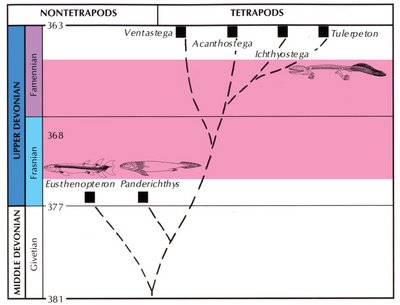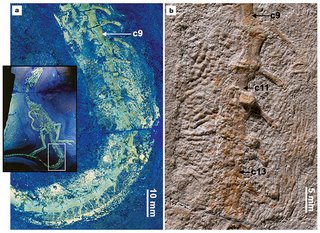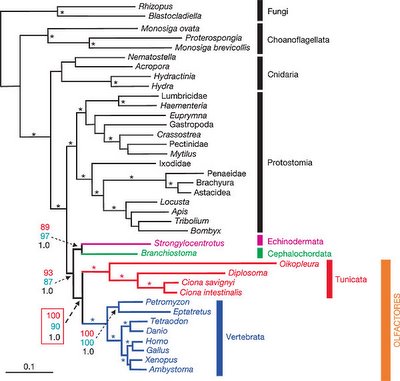The origin of tetrapods is one of the most important and remarkable events in the history of animal life. It is, after all, part of the story of our own origins. According to the fossil record, this event appears to have taken place in the Late Devonian period, between 375 and 365 million years ago. This event gave rise to the lineages that ultimately became humans, dinosaurs, birds, whales, and any other vertebrate that makes a living on land (or had an ancestor that did).
That is to say, the earliest tetrapods we have are known (from complete remains, anyway) from the very latest Devonain, a stage called the Famennian (see the diagram below). We already know that some very fish-like tetrapods called 'elpistostegalians' have been discovered in the earliest part of the Late Devonian, an interval called the Frasnian. Somewhere in the intervening Frasnian and Famennian rocks should be more tetrapods or elpistostegalians.
The diagram below shows some of the most completely known forms surrounding the origin of tetrapods and their distribution in time. The large pink band shows the approximately 10-million-year interval where very few fossils are known. Admittedly, the gap is somewhat exaggerated, there are some fragmentary animals known from this interval.

Modified from Carroll, 1997 Patterns and Processes of Vertebrate Evolution
One can see quite easily that finding more intermediates will involve finding more fossils in Late Devonian rocks. For instance, in the early part of the Frasnian, the elpistostegalian Panderichthys is present and is already very tetrapod-like, but still recognizably a 'fish'. Presumably, more tetrapod-like fishes will be found in rocks of similar date. A prediction is furnished.
To try to bear out this prediction, two intrepid palaeontologists set their sights on some new rock outcrops. Instead of going back to localities that have already been known and worked for decades, Ted Daeschler and Neil Shubin set their sites on a massive band of Devonian rocks in the Canadian Arctic.
An article dating back to 1999 quotes Shubin:
"A place like this that’s so vast and so clearly in the right time period is a great opportunity for us."Daeschler adds:
"the earliest of the limbed animals. Or at the other end, fish that are just beginning to develop limblike structures."As you can see, before Shubin and Daeschler ever set foot in the arctic, they already knew where they were going to look. All the following parameters need to be correct and established independently in order to make the prediction: the age of the rocks, the type of sediment, and the estimation of when the even took place. Then you should be able predict where you will find the fossils you want. In this case, the scientists knew from previous work (done by geologists, independently of they) that there was a huge section of the righ age and type of rocks in the Canadian Arctic.
I'm telling this story for a number of reasons. One, is that it's because I found this article some time ago, but that the results of six years of work in the arctic have not yet come to light. The artcile was written seven years ago when this expedition was being planned and the first year of several years work by Shubin and Daeschler. It's now quite dated and written quite some time before the authors ever went up. It provides perfect evidence for a 'case study' of how palaeontologists work. I'm often asked how palaeontologists know where to dig to find fossils, and this article helps give some insight as to how palaeontologists plan their expeditions.
The key is that the object of the Daeschler and Shubin mission is very rare. To pinpoint where one might find such rare fossils, a lot of things have to go right: the age of the rock formation needs to be known (and correct). The type of environment it was deposited in needs to be correct. Marine-type sediments very rarely have tetrapods or their nearest relatives. Thirdly, your prediction based on the evolutionary sequence seen in the rest of the fossil record has to be accurate. In essence, multiple independent lines of historical evidence are being put to the test. Each one converges to pinpoint where the right fossils of the right type and age will be found.
I'll leave the reader with those thoughts to contemplate and investigate. I'll finish this up later this week.
Read full post




